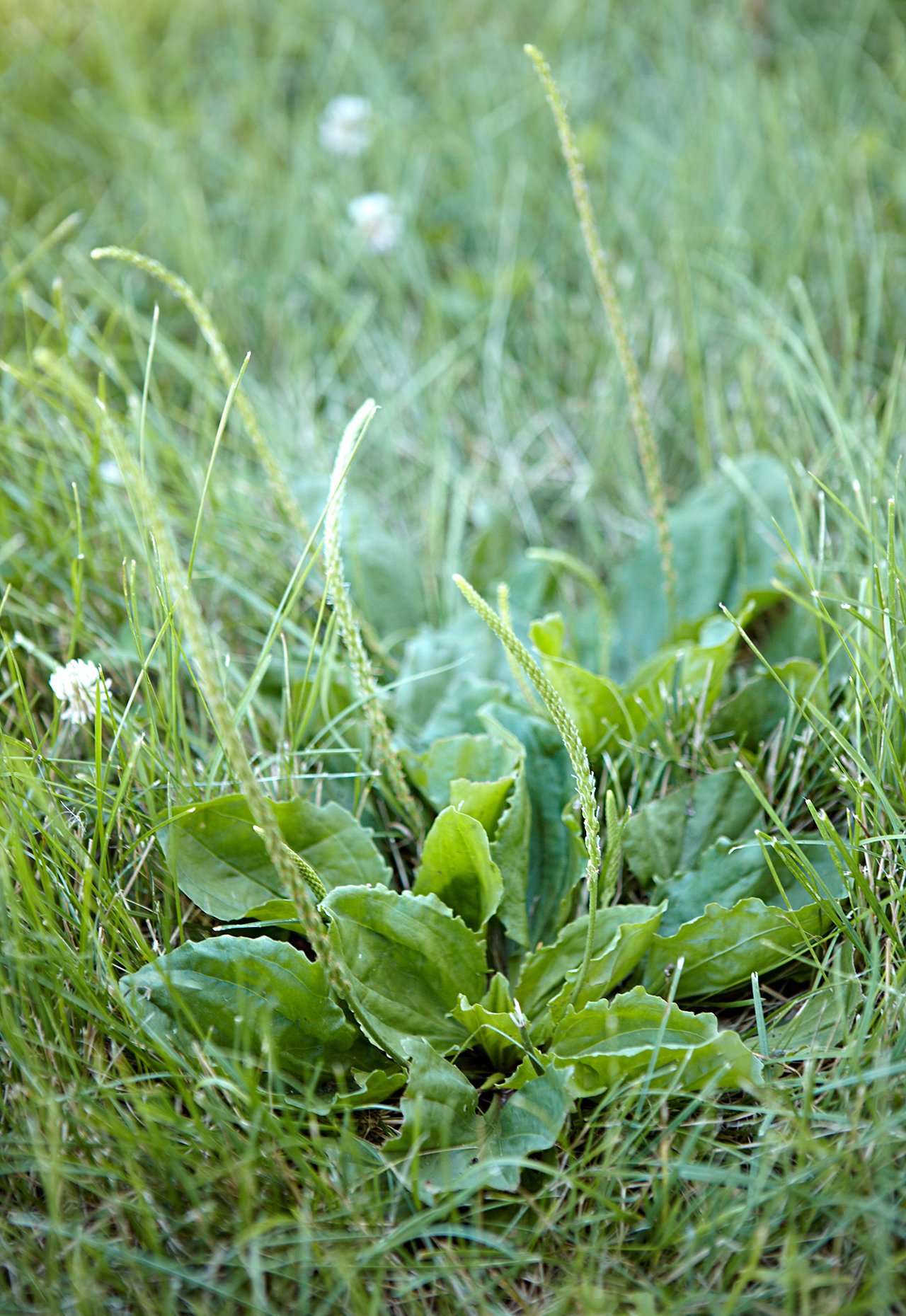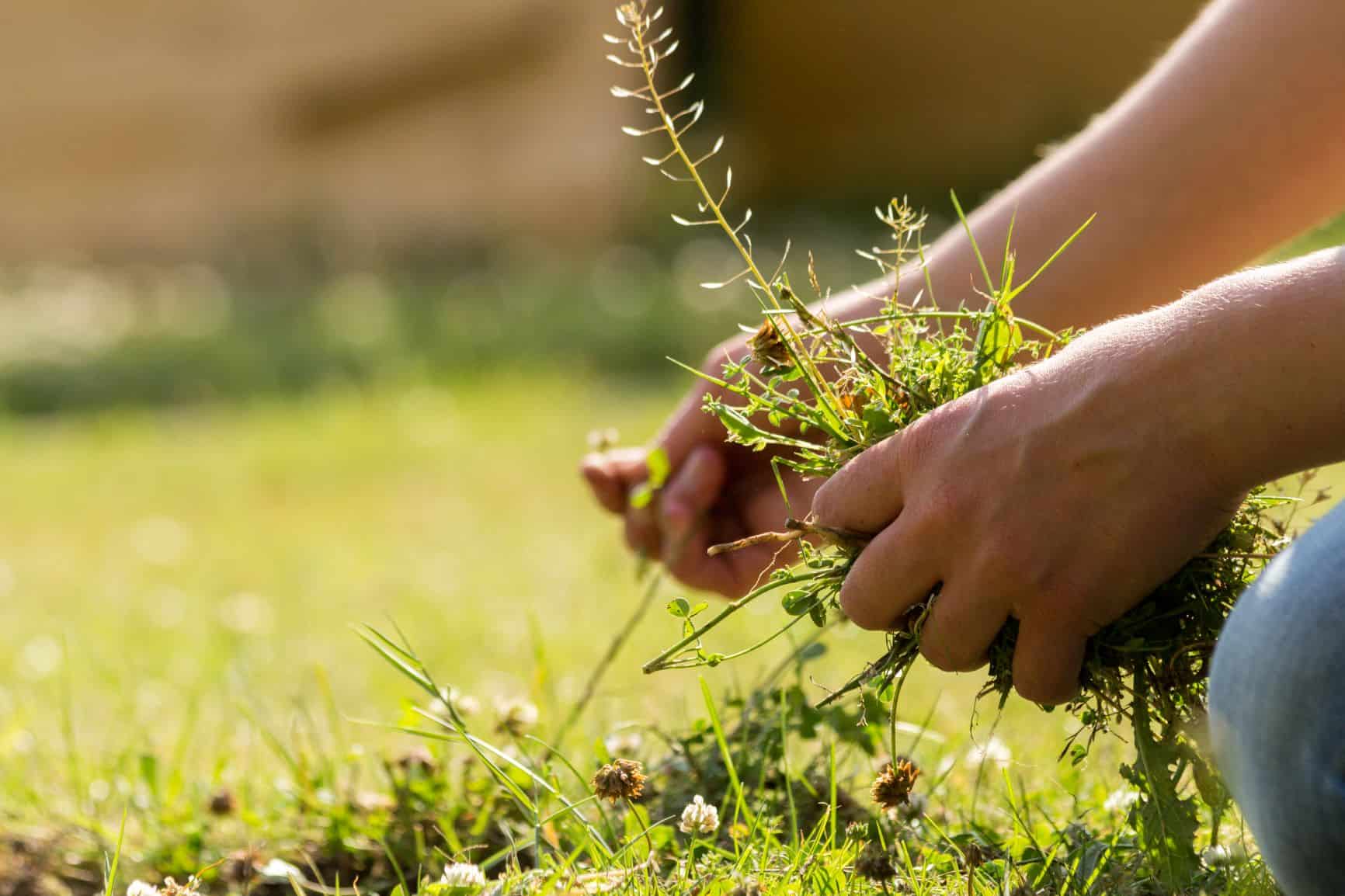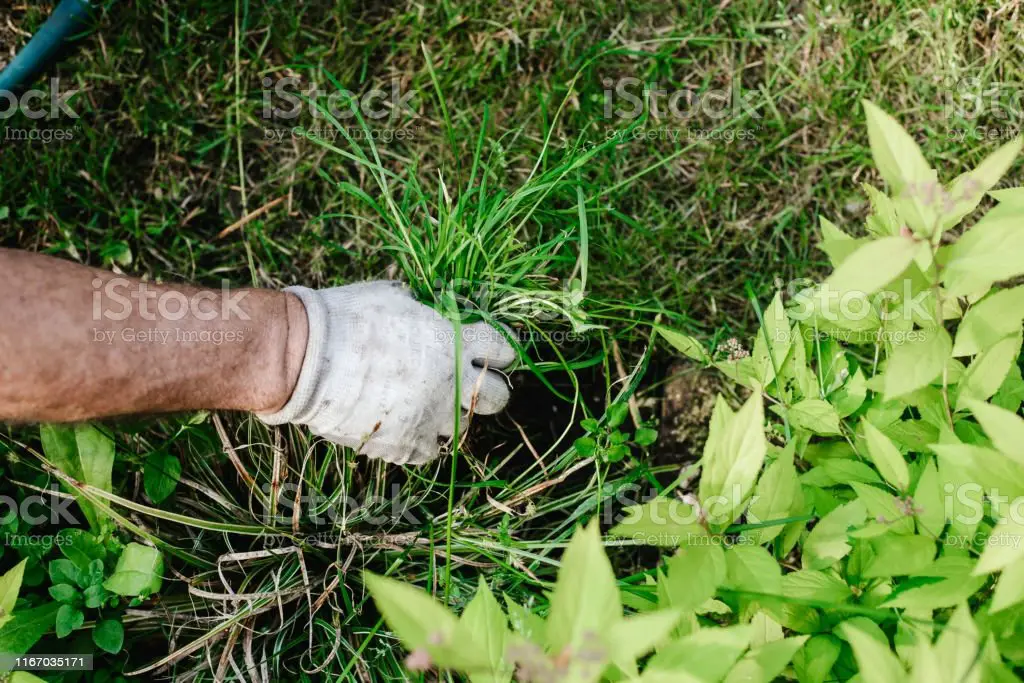How To Remove Weeds From Your Lawn
There are 2 options for removing weeds from your grass, first is to manually dig out the weeds or the second is to apply a chemical weed killer. You can use both methods if your lawn is established but do not use a Feed, Weed and Moss Killer on a newly seeded lawn.
To dig out we can use techniques such as aerating and scarifying the lawn or digging out the weeds with a spade and patching with grass seed.
Alternatively, you can apply chemicals such as Feed, Weed and Mosskiller which will provide nutrients to the grass and root system while killing off any undesirables in the lawn. Be sure to the instructions within the bag when applying. This weed killer usually takes around two weeks to work and can be easily recognised by the moss and weeds turning black. Simply scarify out the dead grasses and reseed if necessary.
How To Prevent Weeds
Although theres no way to weed proof your garden, there are a number of ways to reduce the number and vigor of weeds. Some of the most common methods include:
- Intensive cropping / planting densely
- Covering the soil with mulch or a weed-suppressing layer
- Spreading a chemical weed suppressant on the soil surface
- Deadheading or removing all weeds before they go to seed
Still, no matter how diligent you are in trying to prevent weeds, there will always be the ones that “got away” – and you’ll have to find some way to remove those weeds.
Lawn Weed Removal & Maintenance
If your weed problem is either just getting started, or you recently cleared out all the weeds and have a few coming back, it is important to maintain the weeds as they first come up.
Keeping your lawn well-watered, properly fertilized, and at a proper length are all ways to keep weeds at bay.
Specifically for dandelions, it is important to keep an eye out and pull them out before they seed.
These weeds famously will show you they are in their seeding period when their yellow flower changes into 15,000 seeds in a pouf on top.
Make sure to pull the plant out by the root and remove all root pieces from the grown if possible.
Read Also: What Herbicide Kills Wild Violet
Book A Professional Gardening Service
Dealing with nasty lawn weeds is not a very pleasant gardening chore. If you want to remove every single pesky plant from your garden, you need to, first, know exactly how to do so, have the right tools, and invest many, many hours in the task.
With this being said, why not hire a professional gardening technician to take care of the weeds for you? We, at Fantastic Gardeners Melbourne, offer affordable gardening solutions.
They can include anything from regular lawn care to weed removal for both the garden and lawn.
The service is extremely easy to book, as we already mentioned easy on the budget, and will save you precious time. Forget about trying to clear your lawn from annoying weeds and book our gardening services in Melbourne now!
You dont have to fight the stubborn weeds alone!
Entrust your lawn or garden in the capable hands of a professional local gardener!
Best Tips For Pulling Weeds

Best Tips for Pulling Weeds
On an exhausted field, only weeds grow. Henryk Sienkiewicz
Weeds are the bane of every gardeners existence. Just when you think you have a pristine garden, they pop out of the ground to wreak their havoc. Now, dont get me wrong there are plenty of weeds that look great in a garden or yard. The problem isnt always their appearance, though. Weeds compete with what you actually planned and planted for sun, water, and nutrients. In a contest, the weeds are better at getting what they want than what youre trying to grow. To keep your garden growing the way its intended, taking out the weeds is key.
Tips for Weeding:
Despite hours of tireless work in the hot sun, pesky weeds can keep popping up. For more effective and easier weeding, here are my top tips:
Weed When Wet: This tip is a simple idea that gardeners have been following with great success for centuries. If you pull weeds when the soil is dry, they often get stuck and the roots remain in the soil to grow again. If you pull them after rain or after watering, the soil is easier to move, and the roots will slide out with less resistance. Careful where you step in a wet garden, though, because wet soil is also easier to pack down, smothering your plants and making it harder to pull weeds.
Up and Out: When pulling weeds, tug them straight up rather than on an angle. Angles can cause roots to break off, so up and out is the way to go.
Prevent Weeds:
Recommended Reading: When To Overseed Fescue In Georgia
Natural Weed Prevention Using Landscape Fabric
A chemical can help prevent weeds from growing for only a few months, after which they will reappear if you don’t reapply the chemical. For longer-lasting results, you can use landscape fabric, which prevents them from growing for several years. Landscape fabric blocks the sun from the covered area, preventing unwanted plants from growing, although it still allows air, water, and nutrients to penetrate the soil. You can cut holes in this fabric to allow certain plants to live happily.
Use landscape fabric on any area that you donât want weeds to grow on, large or small, such as a flower bed or a narrow alley that is difficult to mow. Rolls of this material can be purchased from hardware stores like Home Depot or Lowe’s or in the garden section of a grocery store.
When laying down the landscape fabric, there are several steps you need to follow. The following video shows how to lay down landscape fabric around plants, and it is followed by steps that describe how to completely cover an alley.
Common Lawn Weeds And How To Get Rid Of Them
Even the best-tended lawns come under attack from common weeds. Weed seeds float in on the wind, creeping weeds claim more territory, and weeds you thought you pulled quietly continue to grow. How well your lawn copes with the onslaught depends on the weeds involved, the response you choose and your lawns overall health. Understanding common lawn weeds and the options available to fight them can help you successfully combat the invasion.
To help simplify weed defense, weve charted 10 common lawn weeds, including their characteristics, type and how they spread, and most importantly- how to eliminate them. Weeds, like ornamental garden plants, can be annuals or perennials. Annual weeds, such as crabgrass, complete their entire life cycle in a single growing season, and then die, leaving seeds behind to continue the legacy. Perennial weeds, such as dandelions, come back year after year from their roots, and distribute new seeds to boot. Weeds can also be grass-like, broadleaf or sedge. Choosing the right weed control product requires understanding the weed you want to fight and its stage of growth. Pre-emergent weed controls, sometime called preventers, work to keep weed seeds from germinating and developing. Post-emergent weed controls fight weeds that have already germinated and emerged from the soil.
Also Check: How To Get Rid Of Corn Speedwell In Lawn
Roll Out The Landscape Fabric
Unroll the landscape fabric, cut it to fit, then lay down the pieces. You may want to affix the edges with rocks or pegs. If the area you are covering is wider than the width of the fabric, use several overlapping pieces to completely cover the section. If you are accommodating flowers or bushes, cut an x-shaped opening above the plant’s location and then pull it down over the desired plant.
Adding the landscape fabric.
Salt Vinegar And Dish Soap
Do natural weed killers really work? They do if you choose the right ones.
One of the most effective natural weed control methods is a mixture of white vinegar, salt, and liquid dish soap. You can also use apple cider vinegar, if its all you have on hand.
The vinegar contains acetic acid, which, combined with salt, leeches moisture from weeds. The dish soap, meanwhile, is a surfactant, which reduces surface tension on the plants leaves and promotes absorption.
For best results, combine one gallon of white vinegar with one cup of salt and one tablespoon of liquid dish soap. Mix the ingredients in a spray bottle and apply it to weeds at the warmest, sunniest time of the day. The weeds should wither and brown within hours. Spray weeds as needed to prevent re-emergence.
Read Also: How Much Peat Moss For Lawn
Digging Up Weeds Vs Killing Weeds
Related Articles
Weeds in your yard or garden are unwanted pests that you should get rid of before they take nutrients in the soil away from your desirable plants. There are several ways of dealing with weeds. You may choose to kill them with chemicals, kill them by cutting off their tops, or dig them out of the ground. All of these methods have their advantages and disadvantages, which must be carefully weighed before selecting a weed removal option.
How To Kill Weeds Naturally: A Complete Guide
Every homeowner knows the feeling: you walk into your yard ready for some rest and relaxation.
Instead, you see weeds.
Theyre popping up through the cracks in your pavers, invading your garden beds, and rearing their ugly heads in your lawn. Youve tried everything to get rid of weeds forever, and youre starting to get discouraged.
Dont worry, though. Theres hope.
Here at Smiths Pest Management, we provide comprehensive natural weed control as part of our lawn care services to Bay Area homes and businesses, so we know its possible to get rid of weeds with natural deterrents.
In this post, well discuss how to kill weeds naturally, and what steps you can take to get the weed-free outdoor space you want.
Lets dive in.
Recommended Reading: How To Kill Grass Spiders
Pulling Weeds With A Gardening Tool
Pulling weeds by hand is time-consuming, back-breaking work. An alternative is to use gardening tools to help. For shallow-rooted weeds, you can use a regular garden hoe, but for deep-rooted ones, I recommend you use a special tool called a winged weeder.
To remove weeds with the winged weeder, place the bottom tip of the blade right next to the stem and press down vertically to push the blade into the soil and then tilt the weeder downwards towards the ground to pull the whole root out. Repeat this operation as necessary. Note that using this tool is more time-consuming than using a regular hoe as you need to individually remove each unwanted plant, but it works better for deeper roots.
You can purchase these tools from any hardware store.
What Are Some Natural Ways To Kill Weeds In Grass

Pouring boiling water onto the weeds is a good way to both kill the invasive plants at the roots and water the rest of the lawn at the same time. Simply bring your kettle to a boil and walk around your lawn, looking for newly-sprouted weeds. This method works better on sidewalks and other such areas, because the water can kill surrounding grasses if they are not particularly hearty.
There are several organic weed killers available to environmentally-conscious gardeners. One of these, corn gluten meal, is a safe, proven method for eliminating weeds and not killing the grass surrounding it. The milling process prevents weeds from germinating into full-grown plants, but should not be used on newly-grown grass. It also happens to be safe for animals and has the added bonus of adding nitrogen to your lawn. Nitrogen makes for great fertilizer and its one of the elements created when composting as well.
Read Also: What Is The Best All Wheel Drive Lawn Mower
Common Reasons Behind Weed Infestations
Of course, the first step to recovering your beautiful lawn should be finding out what ruined it in the first place. You should try and identify the types of weeds on your property and where they came from.
There are several weeds: Dandelions, Crabgrass, Yellow Nutsedge, Thistle, Quickgrass, and Ragweed all are different in their forms, lifecycles, and methods of spreading. You should find out more about these weeds, identify the ones on your lawn and find the appropriate weed killers.
Clearing Out Pretty Weeds: Moss And Wild Violets
You may appreciate certain weeds, such as moss and wild violets. Some gardeners even cultivate moss plants as an alternative to grass lawns and consider wild violets as wildflowers.
But if you wish to kill the moss in your lawn, it helps to learn more about why it’s grown in your yard in the first place. It may be an indication of deeper soil problems, such as poor drainage and circulation, low soil fertility, and unbalanced levels of pH. Learn how to fix the problems and you’ll be able to kill these weeds permanently.
Though wild violets may appeal to some, you may want to eliminate these purple or white dots from your lawn. Spray the violets in autumn with a triclopyr-based herbicide.
You May Like: How To Grow My Lawn Care Business
Is It Better To Cut Or Pull Weeds
Pulling weeds is far more effective than cutting them with a string trimmer, hoe, or lawn mower. If you pull a weed out entirely, including the roots, then the weed will be killed and will not grow back. If you cut a weed instead of pulling it, the roots of the weed will try to send up new shoots over and over. If you want to get rid of weeds permanently the natural way, pulling them is the way to go.
Using A Chemical Weeding Product
If there are too many weeds to remove manually or with a hoe, you can use a weed killer made of chemicals and spray the chemical directly on each weed. It’s not environment-friendly, so use only if it is absolutely necessary. Some, like Ortho’s Weed-B-Gon, kill many weeds including dandelions, crabgrass, and clover. This product does not damage the lawn. Or you can purchase the concentrate, mix it with water, then spray where needed.
After spraying, you can see results in a day or so. After they die, you’ll have remove them by hand, which is difficult, but much easier than pulling a live weed.
A downside of these chemicals is that they may not kill the weeds entirely. The chemical only kills what it touches, and if it was not sprayed sufficiently, the weed may not die, so make sure to cover all unwanted plants sufficiently.
Also Check: Best Time To Water Lawn In Colorado
How To Get Rid Of A Lawn Full Of Weeds
All year long, we look forward to sinking our feet into lush, radiant green grass. But nobody wants stringy ivy, coarse clovers or fuzzy dandelions grazing your toes instead!
And once you’ve spotted one, you’re sure to see more! Weeds seem to keep multiplying until theyre a huge, unattractive problem.
Luckily, you can bring your lawn back to life by ridding it of weeds and boosting your turf’s health. Heres how to get rid of weeds in your grass for good.
Lawn Weed Identification Is The First Step
Most of these weeds, whether broadleaf or grassy, can be controlled the same way across their specific types.
After your lawn weed identification questions have been answered, its time to get after them and use the proper treatment to remove them from your lawn.
Act quickly, so you dont allow these weeds to gain a foothold in your turf.
Remember whenever youre using herbicides, read the product details before use and wear protective equipment to keep yourself safe.
Follow the manufacturers recommendations to protect your kids, garden plants, and animals, and pay attention to the weather so your weed treatment is effective the first time.
Also Check: Removing Clover From Lawns
Smother Them With Grass
This step is better off done when the larger weeds are gone, but one of the best ways to get rid of weeds in your lawn is to let the grass outgrow them and deny them space to live!
You can do this by feeding your lawn the right fertilizer I highly recommend the Sunday Lawn Care subscription fertilizer plan.
About The Author
Aaron is the founder of and Essential Home and Garden. He likes to spend his spare time with his family, and doing DIY projects in the home and garden.
Old Shower Curtains And Carpet Samples

Want to lay down a weed barrier but dont want to spend money on store-bought landscape fabric? Why not repurpose your old shower curtains and carpet samples?
Both create dense, non-permeable barriers that will smother weeds and prevent light and air from reaching them. Use both exactly the way youd use landscape fabric or newspaper – laying them around plants you want to protect and covering with mulch or gravel.
Read Also: Best Way To Kill Weeds In Yard
Keep Your Garden Edges Trimmed
Ever noticed many weeds collect at the edges of your yard or garden? Keep your grass and garden edges trimmed to cut down on invasions of weeds into your fertile garden soil. The places to watch are the not only the edges of your lawn but also around posts and fence lines as well as close to planting beds. Another idea is to grow perennials or ground roses that will shade those edges and make it easier for you!
